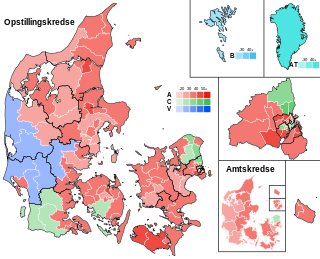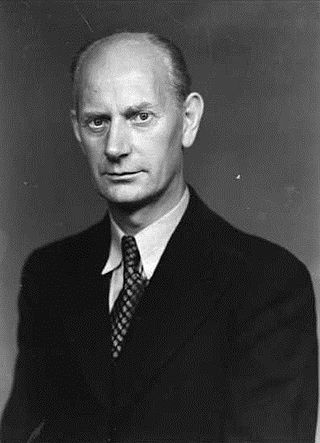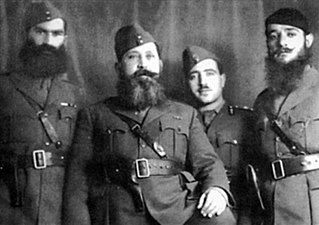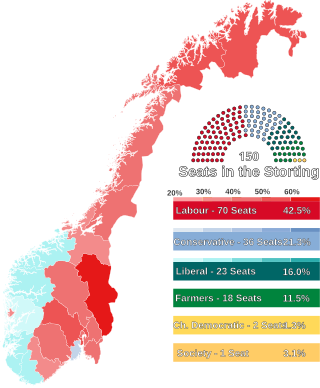
General elections were held in Denmark on 12 December 1990. Although the election resulted in a strong gain for the Social Democratic Party, Poul Schlüter's coalition government was able to continue despite the Danish Social Liberal Party leaving. Schlüter's coalition consisted of the Conservative People's Party and Venstre. Voter turnout was 83% in Denmark proper, 54% in the Faroe Islands and 51% in Greenland.

General elections were held in Denmark on 8 September 1987. Although the Social Democratic Party remained the largest in the Folketing with 54 of the 179 seats, the Conservative People's Party-led coalition government was able to continue. Voter turnout was 87% in Denmark proper, 69% in the Faroe Islands and 45% in Greenland.

General elections were held in Denmark on 10 January 1984, after the opposition voted against the government's state budget bill. Although the Social Democratic Party remained the largest in the Folketing with 56 of the 179 seats, the Conservative People's Party achieved its best-ever result, gaining 16 seats. The coalition partners Venstre and the Christian People's Party also increased their representation, although the fourth government party, the Centre Democrats, lost seven of their 15 seats. Overall the coalition won three more seats, and Poul Schlüter continued as Prime Minister.

Federal elections were held in Germany on 10 January 1877. The National Liberal Party remained the largest party in the Reichstag, with 127 of the 397 seats. Voter turnout was 60.6%.

Parliamentary elections were held in Norway on 11 and 12 September 1977. The Labour Party remained the largest party in the Storting, winning 76 of the 155 seats.

Parliamentary elections were held in Norway on 11 September 1961. The result was a victory for the Labour Party, which won 74 of the 150 seats in the Storting. Although it lost the absolute majority it had held since 1945, the Labour Party was able to continue in government.

Parliamentary elections were held in Norway on 7 October 1957. The result was a victory for the Labour Party, which won 78 of the 150 seats in the Storting. As a result, the Gerhardsen government continued in office.

Parliamentary elections were held in Norway on 12 October 1953. The result was a victory for the Labour Party, which won 77 of the 150 seats in the Storting.

Parliamentary elections were held in Norway on 10 October 1949. The result was a victory for the Labour Party, which won 85 of the 150 seats in the Storting.

Federal elections were held in Germany on 12 January 1912. Although the Social Democratic Party (SPD) had received the most votes in every election since 1890, it had never won the most seats, and in the 1907 elections, it had won fewer than half the seats won by the Centre Party despite receiving over a million more votes. However, the 1912 elections saw the SPD retain its position as the most voted-for party and become the largest party in the Reichstag, winning 110 of the 397 seats.

Parliamentary elections were held in Greece on 31 March 1946. The result was a victory for the United Alignment of Nationalists, an alliance that included the People's Party, the National Liberal Party, and the Reform Party, which won 206 of the 354 seats in Parliament. As a result, Konstantinos Tsaldaris became Prime Minister leading a right-wing coalition. Nonetheless, he soon decided to resign in favor of Themistoklis Sophoulis, who led a government of national unity during the entire second phase of the civil war (1946–1949). One of the priorities of the new government was the proclamation of a plebiscite for the restoration of the Greek monarchy.
Parliamentary elections were held in Greece on 10 October 1993. PASOK of Andreas Papandreou, was elected with 170 of the 300 seats, defeating the liberal-conservative New Democracy party of Constantine Mitsotakis.

Parliamentary elections were held in Norway on 19 October 1936, the last before World War II and the German invasion of Norway. The result was a victory for the Labour Party, which won 70 of the 150 seats in the Storting.
Parliamentary elections were held in Norway on 20 October 1930. The Labour Party won the most seats in the Storting.
Parliamentary elections were held in Norway on 17 October 1927. The Labour Party emergeed as the largest party, winning 59 of the 150 seats in the Storting. However, the subsequent government was headed by Ivar Lykke of the Conservative Party.
Parliamentary elections were held in Norway in 1891. The result was a victory for the Liberal Party, which won 63 of the 114 seats in the Storting. The Conservative Party and the Moderate Liberal Party contested the elections in an alliance, although separate lists were used in some constituencies.

Constituent Assembly elections were held in Bulgaria between 1 and 30 January 1879, although only 117 of the 231 members of the Assembly were elected during this period. It followed the country's liberation from the Ottoman Empire, and saw the Conservative Party and the Liberal Party emerge as the two main parties. The Assembly was opened on 10 February, and convened in Veliko Tarnovo to ratify the country's first constitution, known as the Tarnovo Constitution, on 16 April. The parliament was later transferred to Sofia, which became the capital of the country.
General elections were held in Italy on 3 June 1900, with a second round of voting on 10 June. The "ministerial" left-wing bloc remained the largest in Parliament, winning 296 of the 508 seats.
Parliamentary elections were held in Iceland on 27 October 1923. Voters elected all 28 seats in the Lower House of the Althing and eight of the fourteen seats in Upper House. The Citizens' Party, a loose collection of conservatives, emerged as the largest party in the Lower House, winning 16 of the 28 seats.
The Progressive Conservative Party was a political party in Romania.















